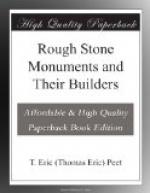An avenue flanked by two rows of stones ran in a south-easterly direction from the rampart towards the village of Kennet for a distance of about 1430 yards in a straight line.
At a distance of 1200 yards due south from Avebury Circle stands the famous artificial mound called Silbury Hill. It is 552 feet in diameter, 130 in height, and has a flat top 102 feet across. A pit was driven down into its centre in 1777, and in 1849 a trench was cut into it from the south side to the centre, but neither gave any result. It is quite possible that there are burials in the mound, whether in megalithic chambers or not.
South-west of Avebury is Hakpen Hill, where there once stood two concentric ellipses of stones. A straight avenue is said to have run from these in a north-westerly direction. Whether these three monuments near Avebury have any connection with one another and, if so, what this connection is, is unknown.
There are many other circles in England, but we have only space to mention briefly some of the more important. At Rollright, in Oxfordshire, there is a circle 100 feet in diameter with a tall menhir 50 yards to the north-east. Derbyshire possesses a famous monument, that of Arbor Low, where a circle is surrounded by a rampart and ditch, while that of Stanton Drew in Somerset consists of a great circle A and two smaller circles B and C. The line joining the centres of B and A passes through a menhir called Hauptville’s Quoit away to the north-east, while that which joins the centres of C and A cuts a group of three menhirs called The Cove, lying to the south-west.
In Cumberland there are several circles. One of these, 330 feet in diameter with an outstanding menhir, is known as “Long Meg and her Daughters.” Another, the Mayborough Circle, is of much the same size, but consists of a tall monolith in the centre of a rampart formed entirely of rather small water-worn stones. A similar circle not far from this is known as King Arthur’s Round Table; here, however, there is no monolith. Near Keswick there is a finely preserved circle, and at Shap there seems to have existed a large circle with an avenue of stones running for over a mile to the north.
Cornwall possesses a number of fine monuments. The most celebrated is the Dance Maen Circle, which is 76 feet in diameter and has two monoliths to the north-east, out of sight of the circle, but stated to be in a straight line with its centre. Local tradition calls the circle “The Merry Maidens,” and has it that the stones are girls turned into stones for dancing on Sunday: the two monoliths are called the Pipers. The three circles known as the Hurlers lie close together with their centres nearly in a straight line in the direction N.N.E. by S.S.W. At Boscawen-un, near Penzance, is a circle called the Nine Maidens, and two circles near Tregeseal have the same name. Another well-known circle in Cornwall is called the Stripple Stones: the circle stands on a platform of earth surrounded by a ditch, outside which is a rampart. In the centre is a menhir 12 feet in height.




